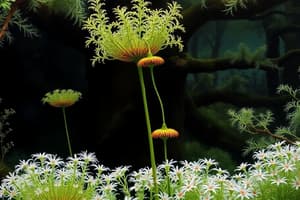Podcast
Questions and Answers
What are pteridophytes commonly referred to as?
What are pteridophytes commonly referred to as?
Ferns and their relatives
Which tissue type carries water and minerals from the roots?
Which tissue type carries water and minerals from the roots?
- Phloem
- Fronds
- Sporangia
- Xylem (correct)
What are the small heart-shaped structures that produce gametes in pteridophytes?
What are the small heart-shaped structures that produce gametes in pteridophytes?
Gametophyte
What is the dominant phase of the pteridophyte life cycle called?
What is the dominant phase of the pteridophyte life cycle called?
What do sori contain?
What do sori contain?
Pteridophytes reproduce only sexually.
Pteridophytes reproduce only sexually.
The underground stems of pteridophytes are known as ______.
The underground stems of pteridophytes are known as ______.
Which of the following groups does not belong to pteridophytes?
Which of the following groups does not belong to pteridophytes?
What type of environments do pteridophytes inhabit?
What type of environments do pteridophytes inhabit?
Match the following pteridophyte classes with their characteristics:
Match the following pteridophyte classes with their characteristics:
Flashcards are hidden until you start studying
Study Notes
Pteridophytes: General Characteristics
- Vascular Tissue: Pteridophytes have xylem, which transports water and minerals, and phloem, which transports sugars. However, their xylem is simpler than that of angiosperms, lacking vessels.
- Reproductive Cycle: Pteridophytes exhibit alternation of generations, with a dominant diploid sporophyte (the familiar fern plant) and a smaller haploid gametophyte (prothallus).
- Spore Production: The sporophyte produces spores through meiosis in specialized structures called sporangia. Sporangia are often grouped in clusters called sori on the underside of fronds.
- Leaves (Fronds): Fronds can be simple or highly divided into leaflets (pinnae). They can be pinnate (feather-like) or pinnatifid (deeply lobed). Fronds emerge from a coiled stage (fiddlehead) and expand as they mature.
- Rhizomes: Underground or creeping stems that anchor the plant and store nutrients. Rhizomes often produce new shoots and roots.
- Reproduction: Pteridophytes can reproduce asexually through vegetative means like rhizome growth, and sexually through the fusion of sperm and egg cells produced by the gametophyte.
- Habitat: Pteridophytes are found in various environments, including rainforests, woodlands, rocky outcrops, and arid regions. Some species are epiphytic (grow on other plants for support).
- Growth Forms: Pteridophytes can be terrestrial (growing in the soil), epiphytic, or aquatic.
- Ecological Role: Pteridophytes contribute to soil formation, provide habitat for organisms, and can act as pioneer species in disturbed areas.
Pteridophyte Classification
- Pteridophytes are divided into three main classes: Lycopsida (club mosses), Filicopsida (ferns), and Equisetopsida (horsetails).
Class Lycopsida (Club Mosses)
- Small, evergreen plants with simple, scale-like leaves.
- Often have a trailing or erect growth habit.
Class Filicopsida (Ferns)
- The most diverse group of pteridophytes.
- Typically have large, divided fronds.
- Can be found in a wide range of habitats.
Class Equisetopsida (Horsetails)
- Jointed stems with a brush-like appearance.
- Have reduced leaves.
- Some species are aquatic.
Studying That Suits You
Use AI to generate personalized quizzes and flashcards to suit your learning preferences.




